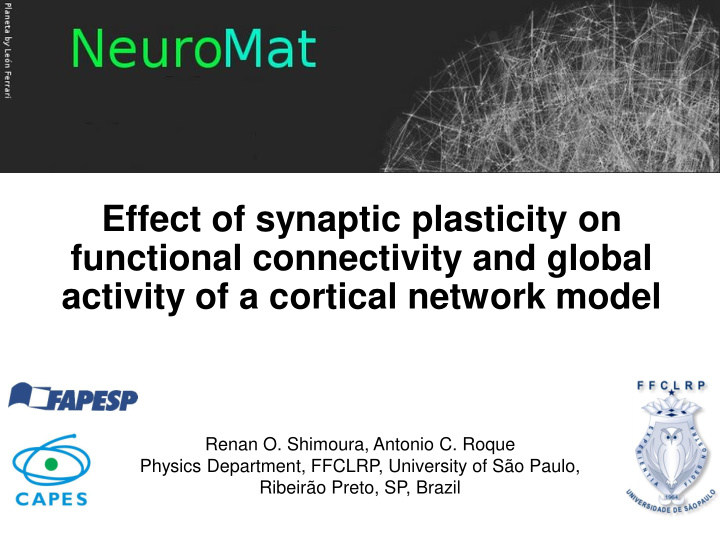



Effect of synaptic plasticity on functional connectivity and global activity of a cortical network model Renan O. Shimoura, Antonio C. Roque Physics Department, FFCLRP, University of São Paulo, Ribeirão Preto, SP, Brazil
Introduction
Cerebral neocortex – Structural organization
General background • Synaptic plasticity is believed to underlie learning and information storage in the brain, as well as neurorecovery after stroke and other brain damage or disease, which are among the main research foci of NeuroMat. • Long-term plasticity can persist from a scale of seconds to hours or more.
Goals
Goals • To study the effect of synaptic plasticity rules on the behavior of neural spiking activity patterns in a cortical network model. • To study the changes in the functional connectivity of the network as disclosed by graph-theoretic measures.
Methods
The network • 4000 neurons; Excitatory neurons Excitatory synapses • Excitatory/inhibitory rate = 4:1; Inhibitory neurons • ~780.000 synapses. Inhibitory synapses Potjans TC, Diesmann M, 2014. The cell-type specific cortical microcircuit: relating structure and activity in a full-scale spiking network model.
Adjacency matrix of topological connections L23e L23i L4e L4i L5e/i L6e L6i L6i L6e L5e/i L4i L4e L23i L23e
Neurons: Izhikevich model 𝐷 𝑒𝑊 If V ≥ 30mV, then: 𝑒𝑢 = 𝑙 𝑊 − 𝑊 𝑊 − 𝑊 𝑢ℎ𝑠𝑓𝑡ℎ𝑝𝑚𝑒 − 𝑣 + 𝐽 𝑠𝑓𝑡𝑢 𝑊 ← 𝑑 𝑒𝑣 𝑣 ← 𝑣 + 𝑒 𝑒𝑢 = 𝑏{𝑐 𝑊 − 𝑊 𝑠𝑓𝑡𝑢 − 𝑣} A) regular spiking ( RS ); B) low threshold spiking ( LTS ); C) fast spiking ( FS ). *Izhikevich EM (2007). Dynamical Systems in Neuroscience: The Geometry of Excitability and Bursting.
Synapse model • Event-based model: 𝑡𝑧𝑜 1 2 If pre- fires a spike, 𝑡𝑧𝑜 → 𝑡𝑧𝑜 + 𝑛𝑏𝑦 𝑒 𝑡𝑧𝑜 = − 𝑡𝑧𝑜 𝑒𝑢 𝜐 𝐽 𝑡𝑧𝑜 = 𝑡𝑧𝑜 (𝑢)(𝑊 𝑢 − 𝐹 𝑡𝑧𝑜 ) ;
Asymmetric spike-time-dependent plasticity (STDP) rule 𝑒𝑁 𝑒𝑄 𝑏 𝜐 − 𝑒𝑢 = −𝑁 𝑓 𝜐 + 𝑒𝑢 = −𝑄 𝑏 If: 1 2 1 2 𝑁 → 𝑁 − 𝐵 − 𝑄 𝑏 → 𝑄 𝑏 + 𝐵 + 𝑛𝑏𝑦 → 𝑛𝑏𝑦 + 𝑄 𝑏 𝑚𝑗𝑛 𝑛𝑏𝑦 → 𝑛𝑏𝑦 + 𝑁 𝑚𝑗𝑛 * Song S, Miller KD, Abbott LF (2000). Competitive Hebbian learning through spike- timing-dependent synaptic plasticity.
Strengthening Weakening t t t t * Song S, Miller KD, Abbott LF (2000). Competitive Hebbian learning through spike- timing-dependent synaptic plasticity.
Simulations • Duration of simulation: 10000 ms; • Input: poissonian spike train generated and connected to neurons of layers 4 (L4) and 6 (L6), which is the main input layers of the cortex; • Electrophysiological classes used: • Excitatory: regular spiking (RS); • Inhibitory: low-threshold spiking (LTS) or fast spiking (FS).
Simulations • Two versions of the model were constructed: • RS_FS • Without synaptic plasticity, • STDP in excitatory synapses. • RS_LTS • Without synaptic plasticity, • STDP in excitatory synapses.
Measures Clustering Coefficient ( C ) *Rubinov M, Sporns O (2010). Complex network measures of brain connectivity: Uses and interpretations. Example of a graph to ilustrate how to calculate C for the node 1. Synchrony index ( C ) 2 𝜏 𝑇 𝑌 2 𝑂 = 2 ; 0 ≤ 𝑌 ≤ 1 1 𝑂 𝑂 𝑗=1 𝜏 𝑇 𝑗 *Golomb D (2007). Neuronal synchrony measures.
Preliminary results
RS – FS: STDP – Excitatory synapses No synaptic plasticity f mean = 0,636 Hz; X = 0,026 f mean = 0,608 Hz; X = 0,027 The version with synaptic plasticity has a little higher frequency and synchrony, but not considerable.
Adjacency matrices of functional connections RS_FS (no plast.) RS_FS (with plast.) C = 0,021 C = 0,024 The functional matrices didn’t show considerable changes.
RS – LTS: STDP – Excitatory synapses No synaptic plasticity f mean = 1,668 Hz; X = 0,067 f mean = 0,744 Hz; X = 0,032 The version with synaptic plasticity has a higher mean frequency. And is possible to see a more synchronous activity of the network.
Adjacency matrices of functional connections RS_LTS (no plast.) RS_LTS (with plast.) C = 0,014 C = 0,246 The formation of clusters of synchronous neural activity was facilitated for the case with synaptic plasticity.
Partial conclusions • Even without specific input patterns, STDP may induce changes in the functional connectivity of the cortical network with impact on its global activity; • The network composition in terms of electrophysiological classes of the neurons has influence on the global activity;
Next steps
Next steps and future studies • To characterize the topological and functional matrices of the network with graph-theoretic measures; • To add STDP on inhibitory synapses and study the effect in this neocortical architecture; • To induce lesions in the network and study the effects of synaptic plasticity in the reorganization of activity.
References
References Golomb D (2007). Neuronal synchrony measures. Scholarpedia , 2(1):1347. Izhikevich EM (2007). Dynamical Systems in Neuroscience: The Geometry of Excitability and Bursting. MIT Press, Cambridge , MA. Song S, Miller KD, Abbott LF (2000). Competitive Hebbian learning through spike-timing-dependent synaptic plasticity. Nat Neurosci 3(9):919-926. Potjans TC, Diesmann M (2014). The cell-type specific cortical microcircuit: relating structure and activity in a full-scale spiking network model. Cereb. Cortex , 24;785-806. Rubinov M, Sporns O (2010). Complex network measures of brain connectivity: Uses and interpretations. NeuroImage , 52:1059-1069.
Recommend
More recommend